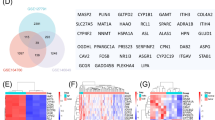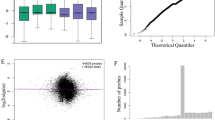Abstract
In this study, we investigated global gene expression in primary rat hepatocytes treated with three active hepatocarcinogens (prednisolone, dehydroepiandrosterone and monocrotaline), three inactive hepatocarcinogens (hydrocortisone, glycyrrhetinic acid and lithocholic acid) and two unclassified chemicals (griseofulvin (possibly active) and prednisone (possibly inactive)). At 48 h after treatment with these eight chemicals, cells were harvested for RNA extraction. Global gene expression analyses were conducted using oligonucleotide microarrays to detect genes whose expression was altered. Differentially expressed genes (DEG) analysis, principal component analysis (PCA), gene set enrichment analysis (GSEA) and KEGG pathway analysis were also conducted. Seven-hundred and sixty genes whose expression was altered >1.2-fold (P<0.05; unpaired Welch’s t-test) were identified as DEGs for the active and inactive carcinogens. In PCA, prednisolone and dehydroepiandrosterone were located away from the inactive carcinogens. In contrast, monocrotaline was close to the inactive carcinogens. Hydrocortisone, glycyrrhetinic acid and lithocholic acid were separate from the active carcinogens. PCA identified griseofulvin as an active carcinogen and prednisone as an inactive carcinogen. GSEA detected several genes associated with hepatocarcinogenesis, such as glutathione S-transferase A2 and NADPH oxidase. KEGG pathway analysis showed that several pathways might be associated with hepatocarcinogenesis. Our results suggest that it may be feasible to differentiate active and inactive hepatocarcinogens by PCA, GSEA and KEGG pathway analysis.
Similar content being viewed by others
References
Mattes, W. B. et al. Research at the interface of industry, academia and regulatory science. Nat Biotechnol 28:432–433 (2010).
O’Brien P. J. et al. High concordance of drug-induced human hepatotoxicity with in vitro cytotoxicity measured in a novel cell-based model using high content screening. Arch Toxicol 80:580–604 (2006).
Lemaire, F. et al. Toxicity assays in nanodrops combining bioassay and morphometric endpoints. PLoS ONE 2:e163 (2007).
Pennie, W., Pettit, S. D. & Lord, P. G. Toxicogenomics in risk assessment: an overview of an HESI collaborative research program. Environ Health Perspect 112:417–419 (2004).
Fielden, M. R., Brennan, R. & Gollub, J. A gene expression biomarker provides early prediction and mechanistic assessment of hepatic tumor induction by nongenotoxic chemicals. Toxicol Sci 99:90–100 (2007).
Subramanian, A. et al. Gene set enrichment analysis: a knowledge-based approach for interpreting genomewide expression profiles. Proc Natl Acad Sci U S A 102:15545–15550 (2005).
van Malenstein, H. et al. A seven-gene set associated with chronic hypoxia of prognostic importance in hepatocellular carcinoma. Clin Cancer Res 16:4278–4288 (2010).
Perkins, E. J. et al. Comparison of transcriptional responses in liver tissue and primary hepatocyte cell cultures after exposure to hexahydro-1,3,5-trinitro-1,3,5-triazine. BMC Bioinformatics 7Suppl 4:S22 (2006).
de Longueville, F. et al. Use of a low-density microarray for studying gene expression patterns induced by hepatotoxicants on primary cultures of rat hepatocytes. Toxicol Sci 75:378–392 (2003).
Dix, D. J. et al. The ToxCast program for prioritizing toxicity testing of environmental chemicals. Toxicol Sci 95:5–12 (2007).
Judson, R. S. et al. In vitro screening of environmental chemicals for targeted testing prioritization: the Tox-Cast project. Environ Health Perspect 118:485–492 (2010).
Barrett, T. et al. NCBI GEO: archive for high-throughput functional genomic data. Nucleic Acids Res 37: D885–890 (2009).
Parkinson, H. et al. ArrayExpress update-from an archive of functional genomics experiments to the atlas of gene expression. Nucleic Acids Res 37:D868–872 (2009).
Roy, K. & Mitra, I. On various metrics used for validation of predictive QSAR models with applications in virtual screening and focused library design. Comb Chem High Throughput Screen 14:450–474 (2011).
Ebalunode, J. O., Zheng, W. & Tropsha, A. Application of QSAR and shape pharmacophore modeling approaches for targeted chemical library design. Methods Mol Biol 685:111–133 (2011).
Author information
Authors and Affiliations
Corresponding author
Rights and permissions
About this article
Cite this article
Kang, J.S., Kang, S., Ryu, DY. et al. Comparative study of active and inactive hepatocarcinogens using a QSAR-based prediction model. Mol. Cell. Toxicol. 8, 383–391 (2012). https://doi.org/10.1007/s13273-012-0047-z
Received:
Accepted:
Published:
Issue Date:
DOI: https://doi.org/10.1007/s13273-012-0047-z




